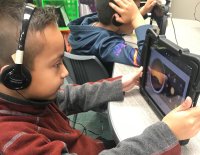A Way to Promote Student Voice—Literally
A second-grade teacher who knew her students had something to say to the world gave them the tools they needed to create a podcast.
Your content has been saved!
Go to My Saved Content.Podcasting offers an empowering way for students—even young ones—to express their ideas and connect with the world. It gives them opportunities to interview people, explain how to do something, teach on a topic, and many other possibilities. And the good news is that podcasting is easier than you may think. But having a growth mindset is important because your students’ efforts might not be perfect the first time you try podcasting—you and your students need to be OK with that.
This year I decided to start podcasting with my second-grade students to empower them to express themselves authentically. I was new to audio recording, so I contacted my digital learning coaches. They were a bit surprised that I wanted to try podcasting with second graders but agreed to help me out.
Though I had a lot to learn, this activity turned out to be a good call—my proud 7-year-old podcasters are already planning more episodes.
The first step we took was to explore a handful of podcasts for about a week. After we talked about podcasting and analyzed some episodes, the students were ready to try creating one of their own. We used an app called Anchor because it seemed very user-friendly. When I’m unsure of how to use an app, I go to YouTube, and I found a video on Anchor that helped me teach my students how to use it properly. One of the district learning coaches was a great help with morale—sometimes it’s scary to try new technology.
Our First Interview
This year, we had a new principal, and my students and I decided that getting to know her through an interview would make a good podcast episode. The class took a week to learn about the principal and to write questions that would help them learn more.
After some discussion and voting, the class selected five questions to ask and five interviewers, who each picked one question. They practiced recording themselves and correcting the audio using GarageBand. In addition, the kids practiced some interpersonal skills like how to shake hands firmly, look a person in the eye, and smile when greeting someone. The rehearsal stage took a week.
The students then requested an appointment for an interview with our principal, who was thrilled that she was going to be interviewed by her second graders. My students were both enthusiastic and nervous when they learned that the principal had agreed to the interview.
One of our digital learning coaches had experience with podcasting, and she shared technical knowledge with my students. She was familiar with how to correctly position a microphone—we used the one built into an iPad—next to an interview subject. We focused on getting the best possible audio of the principal so we wouldn’t have to ask her for another appointment. The coach also helped line up the kids to take turns reading their questions so that we got a good audio recording of their voices with a minimum of noise from their movements.
Editing to Create a Polished Product
The last step was to put everything together, and this step took only one day. Though it was our first time working with Anchor, we discovered that it’s easy to use. The kids voted for music to add to make the episode more appealing, and then a team trimmed the audio to remove some noises at the end.
Finally, we published our podcast, tweeted about it, and sent the link to the episode to my students’ parents. The best part was seeing the kids’ smiles when we finished and noting how proud they were of the result. They got another boost when the district shared our results and applauded how we were supporting one of the district’s big initiatives—to give our students a voice.
This experience gave the students some practice with different apps and increased their technology skills. At the beginning, they had questions about how to use the apps—and they felt nervous. But their initial practice really eased those fears. Now that my students have some experience, they’re deciding what they want to do next. Some of the kids want to explain a topic they are passionate about, and others want to keep interviewing other people. These second graders have strong opinions about how they can use podcasting to demonstrate their learning.
As we move forward, we’ll work on improving the process by using different microphones to improve the quality of the audio we record. We also need to work on mastering Anchor to get the most out of this tool.
Podcasting might seem like a task for older students, but we tried it anyway, and we proved that everyone has something to say.
